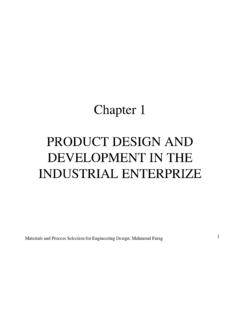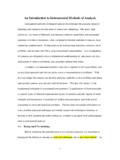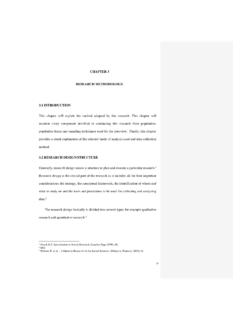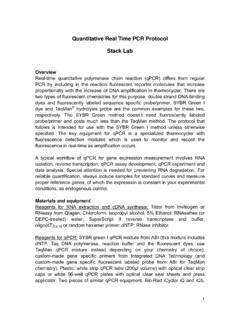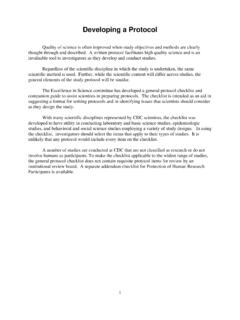Transcription of Chapter 9 THE MATERIALS SELECTION PROCESS
1 MATERIALS and PROCESS SELECTION for Engineering Design: Mahmoud Farag1 Chapter 9 THE MATERIALS SELECTION PROCESS MATERIALS and PROCESS SELECTION for Engineering Design: Mahmoud Farag2 Chapter 9: Goal and objectivesThe overall goal of this Chapter is to illustrate how systematic SELECTION procedures can be used to select optimum MATERIALS and processes for a given component. The main objectives are to illustrate how material performance requirements for a given alternative solutions, screen them, and then rank the viable quantitative methods in MATERIALS computer methods in the SELECTION reliable sources of material nature of the SELECTION processSelecting the optimum combination of material and PROCESS cannot be performed at one certain stage in the history of a project, it should gradually evolve during the different stages of product development.
2 After identifying the function of the component, the following questions become important: What are the primary design and material requirements? What are the secondary requirements and are they necessary? MATERIALS and PROCESS SELECTION for Engineering Design: Mahmoud Farag3 General steps in MATERIALS of the performance requirements. of alternative solutions to the of the different on the optimum and PROCESS SELECTION for Engineering Design: Mahmoud Farag4 Fig. Major stages of design and the related stages of MATERIALS SELECTION I Stages of DesignStages of MATERIALS SelectionPreliminary and Conceptual DesignTranslate marketing ideas into industrial design leading to broad description of the product: What is it? What does it do? How does it do it? How much should it be?
3 Formulate product specifications, develop various concepts and select the optimum conceptDecompose the product into subassemblies and identify the different parts of each subassembly. Specifying the main function of each part and identify their critical of material performance requirements Creating alternative material and PROCESS solutions for the optimum conceptInitial ScreeningUse the critical requirements of each part to define the performance requirements of the material . Start with all MATERIALS available and narrow down the choices on the basis of the rigid and PROCESS SELECTION for Engineering Design: Mahmoud Farag5 Fig. Major stages of design and the related stages of MATERIALS SELECTION IIStages of DesignStages of MATERIALS SelectionConfiguration (Embodiment) DesignDevelop a qualitative sketch of each part giving only the order of magnitude of the main dimensions but showing the main features walls, bosses, ribs, holes, grooves, etcComparing Alternative SolutionsUse soft material requirements to further narrow the field of possible MATERIALS to a few optimum and PROCESS SELECTION for Engineering Design: Mahmoud Farag6 Fig.
4 Major stages of design and the related stages of MATERIALS SELECTION IIIS tages of DesignStages of MATERIALS SelectionDetail (Parametric ) DesignDetermine the dimensions and features of the parts based on a specific material and a manufacturing PROCESS taking into account the design limitations, the manufacturing PROCESS , weight concerns, space limitations, etc. The cost must now be considered in of an alternative detail design, which requires selecting a design based on alternative MATERIALS and evaluation against of Optimum SolutionUse the optimum MATERIALS and matching manufacturing processes to make detail alternative combinations taking into account the elements of optimum combination of design- material -manufacturing processMaterials and PROCESS SELECTION for Engineering Design: Mahmoud Farag7 Analysis of material performance requirementsThe material performance requirements can be divided into 5 broad categories: Functional requirements Processability requirements Cost Reliability requirements Resistance to service conditionsMaterials and PROCESS SELECTION for Engineering Design.
5 Mahmoud Farag8 Creating alternative solutionsHaving specified the material requirements, the rest of the SELECTION PROCESS involves the search for the material that would best meet those starting point is the entire range of engineering MATERIALS . At this stage, it is essential to open up channels in different directions. A steel may be the best material for one design concept while a plastic is best for a different concept, even though the two designs provide similar functions. The importance of this phase is that it creates alternatives without much regard to their and PROCESS SELECTION for Engineering Design: Mahmoud Farag9 Initial screening of solutions IRigid MATERIALS and PROCESS requirementsInitial screening of MATERIALS can be achieved by first classifying their performance requirements into two main categories: Rigid, or go-no-go, requirements.
6 Soft, or relative, that do not satisfy the rigid requirements are eliminated. For example, metals and alloys are eliminated when selecting MATERIALS for an electrical and PROCESS SELECTION for Engineering Design: Mahmoud Farag10 Initial screening of solutions IICost per unit property methodIn the case of tensile members, the cost of unit strength [(C )/S] can be used for initial screening. MATERIALS with lower cost per unit strength are preferable. If an upper limit is set for the quantity (C )/S, then MATERIALS satisfying this condition can be identified and used as possible candidates for more detailed analysis in the next stage of SELECTION . Table gives some formulas for cost per unit property under different loading conditionsMaterials and PROCESS SELECTION for Engineering Design: Mahmoud Farag11 Initial screening of solutions IIIM aterials and PROCESS SELECTION for Engineering Design.
7 Mahmoud Farag12 Table Formulas for estimating cost per unit property Cross-section and loading condition Cost per unit strength Cost per unit stiffness Solid cylinder in tension or compression C /S C /E Solid cylinder in bending C /S2/3 C /E1/2 Solid cylinder in torsion C /S2/3 C /G1/2 Solid cylindrical bar as slender column --- C /E1/2 Solid rectangle in bending C /S1/2 C /E1/3 Thin-walled cylindrical pressure vessel C /S --- Initial screening of solutions IV Case study a beam material for minimum cost IA simply supported beam of rectangular cross section of length 1 meter, width 100 mm, and no restriction on the depth is subjected to a load of 20 kN in its middle. The main design requirement is that the beam should not suffer plastic deformation as a result of load application.
8 Select the least expensive material for the beam from Table and PROCESS SELECTION for Engineering Design: Mahmoud Farag13 Initial screening of solutions IV Case study a beam material for minimum cost IIMaterials and PROCESS SELECTION for Engineering Design: Mahmoud Farag14 Table Characteristics of candidate MATERIALS for the beam material Working stress a Specific gravity Relative cost b Cost of unit strength MPa ksi Steel AISI 1020, normalized 117 17 1 Steel AISI 4140, normalized 222 32 Aluminum 6061, T6 temper 93 6 Epoxy+70% glass fibers 70 9 a The working stress is computed from yield strength using a factor of safety of 3. b The relative cost per unit weight is based on AISI 1020 steel as unity. material and processing costs are included in the relative cost.
9 Initial screening of solutions IV Case study a beam material for minimum cost IIIS olution: Based on Table and the appropriate formula from Table , the cost of unit strength for the different MATERIALS is calculated and the results are given in the last column of Table The results show that steels AISI 1020 and 4140 are equally suitable, while Al 6061 and epoxy -glass are more expensive. MATERIALS and PROCESS SELECTION for Engineering Design: Mahmoud Farag15 Ashby s methodfor initial screeningIMaterials and PROCESS SELECTION for Engineering Design: Mahmoud Farag16 Ashby s method for initial screeningIIMaterials and PROCESS SELECTION for Engineering Design: Mahmoud Farag17 Comparing and ranking alternatives IWeighted properties method IIn this method each material requirement is assigned a certain weight, depending on its weighted property value is obtained by multiplying the scaled value of the property by the weighting factor ( ).
10 The weighted property values of each material are then summed to give a performance index ( ). The material with the highest performance index ( ) is optimum for the and PROCESS SELECTION for Engineering Design: Mahmoud Farag18 Comparing and ranking alternatives IWeighted properties method IIForcost,corrosionloss,etc.,alowervalue ismoredesirableandthelowestvalueisrateda s100minimumvalueinthelistx100B=scaledpro perty=---------------------------------- -------numericalvalueofpropertynMaterial performanceindex= = Bi ii= and PROCESS SELECTION for Engineering Design: Mahmoud Farag19 Comparing and ranking alternatives IThe Digital Logic MethodMaterials and PROCESS SELECTION for Engineering Design: Mahmoud Farag20 Table Determination of the relative importance of goals using the digital logic method Goals Number of positive decisions N = n(n -1)/2 Positive decisions Relative emphasis coefficient 1 2 3 4 5 6 7 8 9 10 1 1 1 0 1 3 2 0 1 0 1 2 3 0 0 1 0 1 4 1 1 0 0 2 5 0 0 1 1 2 Total number of positive decisions 10 = Comparing and ranking alternatives ITaking cost into considerationCost can be considered as one of the properties and given a weighting factor or considered separately as a modifier to the material performance index ( ).
